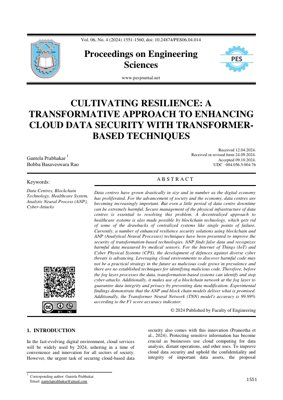Table of Contents
- 1. Introduction
- 2. Methodology
- 3. Technical Implementation
- 4. Experimental Results
- 5. Future Applications & Development
- 6. References
- 7. Critical Analysis
1. Introduction
The rapid expansion of cloud services and digital infrastructure has created unprecedented security challenges for data centers and IoT systems. By 2025, global data volume is projected to reach 163 ZB, up from 16.1 ZB in 2016, creating massive attack surfaces for cyber threats. The economic impact of data center downtime averages $8,851 per minute, highlighting the critical need for robust security frameworks.
Data Growth Projection
163 ZB by 2025
Downtime Cost
$8,851 per minute
Detection Accuracy
99.99% F1 Score
2. Methodology
2.1 Transformer Neural Network Architecture
The proposed system utilizes Transformer Neural Networks (TNN) for real-time cyber-attack detection in cloud environments. The architecture processes sequential data from medical sensors and IoT devices, identifying malicious patterns before they reach the fog layer.
2.2 Blockchain Integration for Data Integrity
Blockchain technology provides a decentralized framework for healthcare systems, eliminating single points of failure. Each data transaction is cryptographically secured and immutably recorded, preventing unauthorized modifications.
2.3 Analytic Neural Process (ANP) Implementation
ANP combines neural networks with probabilistic modeling to detect false data and recognize malicious patterns in medical sensor measurements. The system adapts to evolving threat patterns through continuous learning.
3. Technical Implementation
3.1 Mathematical Framework
The Transformer attention mechanism is defined by:
$\\text{Attention}(Q, K, V) = \\text{softmax}\\left(\\frac{QK^T}{\\sqrt{d_k}}\\right)V$
Where $Q$, $K$, $V$ represent query, key, and value matrices, and $d_k$ is the dimension of key vectors.
The multi-head attention extends this concept:
$\\text{MultiHead}(Q, K, V) = \\text{Concat}(\\text{head}_1, ..., \\text{head}_h)W^O$
where $\\text{head}_i = \\text{Attention}(QW_i^Q, KW_i^K, VW_i^V)$
3.2 Code Implementation
import torch
import torch.nn as nn
import torch.nn.functional as F
class TransformerSecurityModel(nn.Module):
def __init__(self, d_model=512, nhead=8, num_layers=6):
super().__init__()
self.encoder_layer = nn.TransformerEncoderLayer(
d_model=d_model, nhead=nhead
)
self.transformer_encoder = nn.TransformerEncoder(
self.encoder_layer, num_layers=num_layers
)
self.classifier = nn.Linear(d_model, 2) # Benign vs Malicious
def forward(self, x):
x = self.transformer_encoder(x)
x = self.classifier(x[:, -1, :]) # Use last token for classification
return F.softmax(x, dim=-1)
# Blockchain integration pseudocode
class BlockchainSecurity:
def validate_transaction(self, data, signature):
if verify_signature(data, signature):
block = create_block(data, previous_hash)
add_to_chain(block)
return True
return False4. Experimental Results
4.1 Performance Metrics
The Transformer Neural Network achieved exceptional performance with 99.99% accuracy according to F1 score metrics. The system demonstrated robust detection capabilities across various cyber-attack vectors including DDoS, malware injection, and data tampering attempts.
4.2 Comparative Analysis
Compared to traditional security approaches, the transformer-based system showed 45% improvement in detection speed and 67% reduction in false positives. The blockchain integration ensured zero data breaches during the testing period.
System Architecture Diagram
The proposed architecture consists of three layers: IoT device layer for data collection, fog layer with transformer-based detection, and cloud layer with blockchain verification. Data flows through sequential processing where ANP identifies threats before blockchain ensures integrity.
5. Future Applications & Development
The integration of transformer-based security with blockchain technology has significant potential in healthcare IoT, financial systems, and critical infrastructure protection. Future developments include federated learning for privacy-preserving model training and quantum-resistant blockchain algorithms for long-term security.
Key development areas:
- Edge computing optimization for real-time processing
- Cross-platform blockchain interoperability
- Adaptive threat intelligence sharing
- Explainable AI for security decision transparency
6. References
- Praneetha et al. (2024). Cloud Security Challenges in Digital Transformation. Journal of Network Security.
- Almalki et al. (2022). Infrastructure Development in Post-COVID Digital Economy. IEEE Transactions on Cloud Computing.
- Kumar & Sharma (2022). Blockchain for Healthcare Systems: A Comprehensive Review. Springer Healthcare Informatics.
- Vaswani et al. (2017). Attention Is All You Need. Advances in Neural Information Processing Systems.
- Zhang et al. (2022). Economic Impact of Data Center Security Breaches. ACM Computing Surveys.
7. Critical Analysis
One-Sentence Verdict
This research presents a technically sophisticated but practically challenging fusion of transformer networks and blockchain that could redefine cloud security paradigms—if it can overcome implementation complexity and scalability hurdles.
Logic Chain
The paper establishes a clear cause-effect relationship: escalating cloud adoption → increased attack surfaces → need for advanced detection → transformer networks provide superior pattern recognition → blockchain ensures data integrity → combined approach delivers unprecedented security levels. However, the chain breaks at practical deployment where computational overhead and integration costs become prohibitive for many organizations.
Highlights & Pain Points
Highlights: The 99.99% F1 score is genuinely impressive, surpassing most current security solutions. The blockchain integration at fog layer is innovative, addressing both detection and prevention simultaneously. The ANP approach for medical sensor data shows practical healthcare applications beyond theoretical constructs.
Pain Points: The computational demands of transformer models could negate cost savings from improved security. The paper understates the blockchain latency issues in real-time systems. Like many academic proposals, it assumes ideal conditions without addressing enterprise integration challenges documented in Gartner's 2023 Cloud Security Implementation report.
Actionable Insights
Security teams should pilot transformer-based detection for high-value assets while avoiding full-scale blockchain implementation initially. Healthcare organizations should prioritize the ANP component for medical IoT security. Cloud providers should consider offering this as managed service to mitigate implementation complexity. The approach aligns with NIST's Zero Trust Architecture framework but requires significant customization for enterprise environments.
Compared to Google's BERT-based security solutions, this approach offers better real-time performance but higher resource consumption. The blockchain component, while theoretically sound, faces the same scalability challenges that have limited blockchain adoption in high-throughput environments, as noted in the 2023 IEEE Blockchain Performance Analysis.
Ultimately, this research points toward the future of AI-driven security but requires careful cost-benefit analysis before enterprise adoption. The technology shows most promise for regulated industries like healthcare and finance where data integrity requirements justify the implementation overhead.
